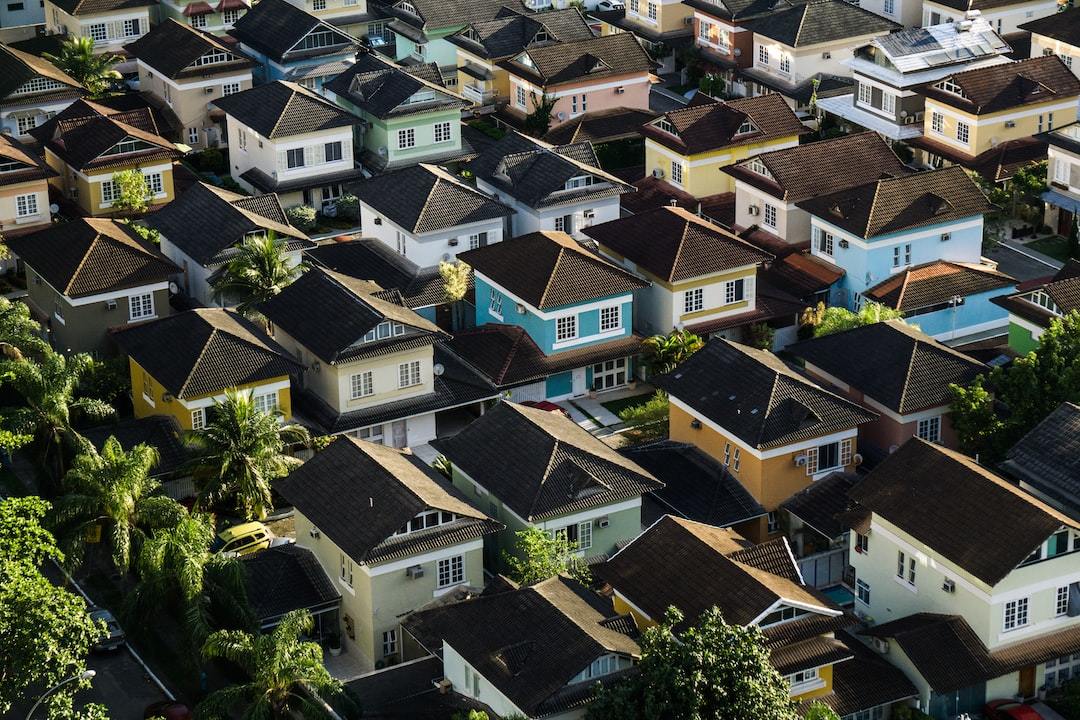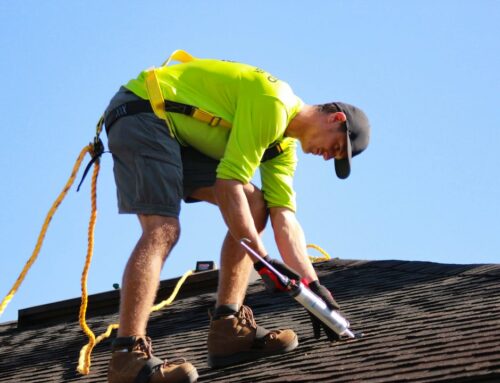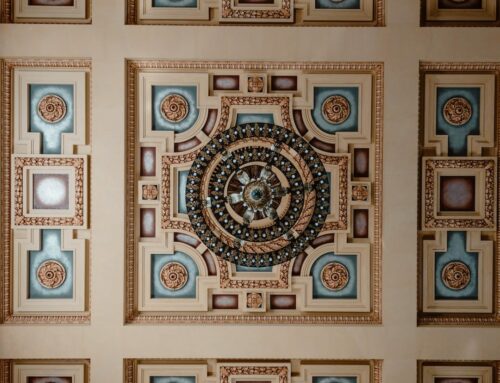How long does a roof last? This is a frequent inquiry among property holders, particularly those in the Kansas City metropolitan region where climate conditions can be very intense. The answer depends on several factors such as the type of roofing materials used, regular roof maintenance practices, and local climate.
In this blog post, we will delve into the lifespan of various roofing systems including asphalt shingle roofs, metal roofs, and more exotic options like slate or clay tile roofs. We’ll also explore how different factors like proper maintenance and weather conditions can impact your current roof’s lifespan.
We will then discuss eco-friendly alternatives that not only have a longer lifespan but also contribute to environmental sustainability. Lastly, we’ll emphasize the importance of performing roof repairs promptly when you notice signs like missing or damaged shingles to prevent further damage and potentially extend your roof’s life expectancy.
Table of Contents:
- The Lifespan of Different Roofing Materials
- Eco-Friendly and Durable Roofing Options
- Synthetic Shingles and TPO (Thermoplastic Olefin) Roofing
- Wood vs Metal vs Copper Concrete Tile Roofings
- Importance of Maintenance in Ensuring Your Rooftop’s Longevity
- FAQs in Relation to How Long Does a Roof Last
- Conclusion
The Lifespan of Different Roofing Materials
The life expectancy of roofing materials varies greatly, with asphalt shingles generally having a lifespan of around 30 years and other materials lasting up to 100. The most common roofing material, asphalt shingles, is popular due to its durability and affordability. Generally, asphalt shingles can last up to three decades.
Understanding the Durability of Asphalt Shingles
Asphalt shingles are made from fiberglass sandwiched between asphalt and ceramic granules. This composition makes them resistant to weather damage and allows for an average lifespan of around three decades with proper maintenance.
Architectural Asphalt Shingle’s Lifespan
In contrast, architectural asphalt shingles are thicker than regular ones providing extra strength against harsh elements. These types can endure up to 25 years under optimal conditions but may require more frequent inspections due to their complex design structure.
Standing Seam Metal Roofs Longevity
Standing seam metal roofs, known for their distinctive vertical panels, offer another durable option with a life expectancy ranging between two to five decades depending on climate conditions where they’re installed.
Clay Tiles: Aesthetic Appeal with Longevity
If you’re looking for both aesthetic appeal and longevity in your roof choice, then clay tiles might be the perfect fit. Not only do they add a unique charm to any home exterior, but they also boast impressive lifespans reaching up to the century mark, making them an ideal long-term investment into property infrastructure. However, keep in mind that these materials tend to be heavier, hence requiring additional structural support to ensure safety over time.
To make sure your roof lasts as long as possible, it’s important to choose the right material based not just on cost considerations but also on factors like local weather patterns, and building codes, among others. Pyramid Roofing provides customers with reliable information needed to make the right decisions regarding these crucial aspects of homeownership, thereby guaranteeing durable and cost-effective solutions tailored to meet the unique needs and preferences of every homeowner in the Kansas City metropolitan area.
Key Takeaway:
The article discusses the lifespan of different roofing materials, ranging from asphalt shingles to clay tiles. It highlights that proper maintenance can extend the life expectancy of roofs and advises homeowners to choose a material based on factors such as local weather patterns and building codes. Pyramid Roofing provides reliable information to help homeowners make informed decisions about their roofing needs in the Kansas City metropolitan area.
Eco-Friendly and Durable Roofing Options
For those looking to be environmentally conscious, there are a variety of roofing options that offer durability and reduce your environmental impacts, such as slate tile roofs and solar roofing tiles. Two of these eco-friendly choices include slate tile roofs and solar roofing tiles.
Slate Tile Roofs for Environmentally Conscious Homeowners
Slate tile roofs have been used for centuries due to their exceptional longevity and timeless beauty. Made from natural stone, they’re highly resistant to weather conditions and can last up to an impressive 150 years with proper maintenance. This makes them a great investment as they rarely need replacement compared to other materials.
Solar Roofing Tiles – An Emerging Trend
In recent years, solar roofing tiles have emerged as a promising trend in the industry. These innovative tiles generate electricity from sunlight while providing protection against the elements just like traditional roof shingles do. Despite their higher upfront costs compared to asphalt or slate, solar tiles promise potential lifespans reaching up to a century mark making them an excellent long-term investment.
The choice between slate tile roofs and solar roofing tiles ultimately depends on your specific needs, budget, aesthetic preferences, and commitment to sustainability. Both options provide homeowners in the Kansas City metropolitan area with durable solutions that contribute positively towards environmental conservation efforts without compromising on quality or performance.
Besides being environmentally friendly alternatives, both these types of rooftops require minimal maintenance ensuring peak condition throughout their service life which is another significant advantage considering how crucial regular upkeep is when it comes down to maintaining structural integrity over time.
No matter what type of rooftop you choose, Pyramid Roofing provides reliable information needed to make the right decisions regarding these aspects, thereby guaranteeing durable cost-effective solutions tailored to meet the unique needs and preferences of every homeowner.
Key Takeaway:
The article discusses eco-friendly and durable roofing options for homeowners, including slate tile roofs and solar roofing tiles. Slate tile roofs are made from natural stone, highly resistant to weather conditions, and can last up to 150 years with proper maintenance. Solar roofing tiles generate electricity from sunlight while providing protection against the elements like traditional roof shingles do and have a potential lifespan of up to a century mark despite their higher upfront costs compared to other materials. Both options provide environmentally conscious solutions that require minimal maintenance ensuring peak condition throughout their service life.
Synthetic Shingles and TPO (Thermoplastic Olefin) Roofing
Choosing the right roofing material for your home in the Kansas City metropolitan area can be a daunting task. But, if you’re looking for sustainability and longevity, synthetic shingles and TPO (Thermoplastic Olefin) roofing is two options that stand out.
Synthetic Shingles – A Sustainable and Stylish Choice
Synthetic shingles, crafted from recycled materials, offer an environmentally-friendly choice that doesn’t skimp on style or strength. They come in a variety of colors and styles, mimicking the look of slate or cedar shake roofs. Plus, they can last up to 70 years with proper maintenance, making them a smart long-term investment for your home.
- Durable: Synthetic shingle roofs can last over 70 years with proper maintenance.
- Eco-Friendly: Made from recycled plastic or rubber materials, synthetic shingles reduce landfill waste.
- Stylish: Available in a variety of colors and styles, synthetic shingle roofs can enhance any home’s curb appeal.
TPO (Thermoplastic Olefin) Roofing – A Modern and Eco-Friendly Option
If you’re looking for a more modern option, TPO roofing might be worth considering. Made from recycled rubber material, TPO roofs are easy to install and can last up to 30 years with regular maintenance and inspections. They also offer excellent resistance against UV rays, making them suitable for the harsh summer months in the Kansas City metropolitan area.
- Durable: With regular maintenance and inspections, TPO roofs can last up to 30 years.
- Eco-Friendly: Made primarily from recyclable content, TPO roofing reduces environmental impact significantly.
- Versatile: Comes in varying thicknesses and color options, providing flexibility when matching existing aesthetic preferences.
For those seeking an eco-friendly and long-lasting roofing material, synthetic shingles, and TPO roofing offer a range of colors, thicknesses, and styles to match any aesthetic.
Key Takeaway:
The article discusses two sustainable and long-lasting roofing options for homes in the Kansas City metropolitan area: synthetic shingles made from recycled materials that can last up to 70 years with proper maintenance, and TPO (Thermoplastic Olefin) roofing made from a recycled rubber material that offers excellent resistance against UV rays and can last up to 30 years with regular maintenance. Both options are eco-friendly and durable, and come in a variety of styles/colors to enhance any home’s curb appeal.
Wood vs Metal vs Copper Concrete Tile Roofings
Wood, metal, and copper concrete tile are all great options, each with its own unique benefits.
Wooden vs Metal Rooftops: Pros and Cons
Wood shingle roofs offer natural beauty and excellent insulation, but require regular maintenance and can be a fire hazard if not treated properly. Metal roofs boast a long lifespan and are able to withstand harsh weather conditions, though they may be noisy during storms if not properly insulated.
- Pros of Wood Shingles: Natural aesthetic appeal; excellent insulation properties; relatively easy installation.
- Cons of Wood Shingles: Require regular maintenance; susceptible to fire if not treated properly.
- Pros of Metal Roofs: Long lifespan; resistant to extreme weather conditions; energy-efficient due to their reflective nature.
- Cons of Metal Roofs: Higher initial cost compared to other materials; noise during heavy rain or hail storms unless properly insulated.
Copper, Concrete, and Clay Tiles
Copper concrete tiles, clay tiles, and some types of wood shingle slate all have lifespans of around 50 years or more, potentially extending beyond with the quality installation and regular upkeep. Copper roofing, although expensive initially, is a worthwhile investment due to its lifespan of over 70 years and unique curb appeal. Concrete and clay tiles are known for their strength, durability, and fireproof properties, providing homeowners with peace of mind knowing they’ve chosen a reliable and durable solution to protect their homes.
For more information on the pros and cons of different roofing materials, check out Bob Vila and Tile Roofs of Florida.
Importance of Maintenance in Ensuring Your Rooftop’s Longevity
Maintaining your roof is essential for extending its life, regardless of the material used. Maintenance plays a crucial role in preserving its lifespan. Poor ventilation, for instance, could lead to premature damage and necessitate a total roof replacement sooner than expected.
The Role of Ventilation in Maintaining Your Rooftop’s Health
Proper ventilation allows air to flow freely through your attic space, preventing heat and moisture buildup that can cause rot and mold growth, weakening the structure over time. Regularly checking your vents for blockages or damages is essential to maintaining a healthy rooftop.
Maintaining Clean Gutters to Ensure a Longer Lifespan
Clean gutters are equally important in prolonging the lifespan of your roof. Leaves, snow, and other debris can accumulate in gutters, causing water back up onto the roof, leading to moisture damage. Regular cleaning, especially during fall when leaves are most likely to clog up drains, will prevent this problem.
In addition to these aspects, regular inspections by professional roofing contractors like Pyramid Roofing can help identify potential issues before they become major problems. We provide our customers with reliable information needed to make informed decisions regarding their roof’s health, guaranteeing durable cost-effective solutions tailored uniquely for every homeowner in the Kansas City metropolitan area.
- Schedule Annual Inspections: A yearly inspection by professionals helps detect minor issues before they escalate into significant problems requiring costly repairs or replacements.
- Promptly Address Leaks: Any sign of leakage should be addressed immediately since water seeping into your home can result in structural damage over time.
- Maintenance After Severe Weather: After extreme weather conditions such as storms or heavy snowfall, it’s crucial to inspect your rooftop for any signs of damage and ensure quick repair to restore optimal condition.
Key Takeaway:
The article discusses the importance of maintenance in ensuring the longevity of a roof. Proper ventilation and clean gutters are crucial factors that contribute to maintaining a healthy rooftop, while regular inspections by professional roofing contractors can help identify potential issues before they become major problems. It is also important to schedule annual inspections, promptly address leaks, and perform maintenance after severe weather conditions.
FAQs in Relation to How Long Does a Roof Last
How Long Should Your Roof Last?
The lifespan of your roof depends on the material used and maintenance performed, typically ranging from 20 to 50 years.
Do “25-Year” Roofs Really Last 25 Years?
A properly cared for “25-year” asphalt shingle roof can last between 15 to 30 years.
How Long Does a “30-Year” Roof Really Last?
Architectural asphalt shingle roofs with a “30-year” rating tend to last around 27 to 35 years.
Do “40-Year” Shingles Really Last 40 Years?
High-quality composite shingles with a “40-year” rating may reach their stated lifespan, but are more likely to last around 30 to 38 years.
Why Choose Pyramid Roofing?
- Expert roofing services tailored to your specific needs and budget.
- Competitive pricing without sacrificing quality.
- Trusted by homeowners and businesses alike.
Conclusion
As we conclude our exploration into the lifespan of roofs, we hope you’ve gained valuable insights and a deeper understanding of this essential aspect of your home. From asphalt shingles to metal panels and beyond, roofs play a vital role in safeguarding our houses and protecting us from the elements.
Remember, while there are general estimates for the longevity of different roofing materials, many factors influence how long a roof will last. Climate conditions, maintenance practices, installation quality, and material durability all play their part in determining the lifespan of your roof.
Investing in regular roof inspections, prompt repairs, and appropriate maintenance can significantly extend the life expectancy of your roof. Proper ventilation, gutter cleaning, and proactive measures like removing debris and trimming overhanging branches can go a long way in preserving the integrity of your roof.
If you find yourself facing the need for a roof replacement, take the time to research and select the best roofing material for your specific needs and budget. Consider consulting with professionals who can provide expert advice tailored to your region and requirements.
Remember, a well-maintained roof not only protects your home but also enhances its overall aesthetic appeal and value. So, don’t underestimate the significance of this critical feature.
We hope this blog has empowered you with the knowledge to make informed decisions regarding your roof and its upkeep. Whether you’re a homeowner seeking to extend the lifespan of your existing roof or a prospective buyer evaluating the condition of a property, understanding the lifespan of roofs is crucial.







